Machine Learning Models for Enhanced Estimation of Soil Moisture Using Wideband Radar Sensor
Abstract
1. Introduction
2. Materials and Methods
2.1. System Setup
2.2. Methods and Approach
3. Results and Discussion
4. Conclusions
Author Contributions
Funding
Institutional Review Board Statement
Informed Consent Statement
Data Availability Statement
Acknowledgments
Conflicts of Interest
References
- Karthikeyan, L.; Pan, M.; Wanders, N.; Kumar, D.N.; Wood, E.F. Four decades of microwave satellite soil moisture observations: Part 1. A review of retrieval algorithms. Adv. Water Resour. 2017, 109, 106–120. [Google Scholar] [CrossRef]
- Lakshmi, V. Remote sensing of soil moisture. ISRN Soil Sci. 2013, 2013, 424178. [Google Scholar] [CrossRef]
- Liang, J.; Liu, X.; Liao, K. Soil Moisture Retrieval Using UWB Echoes via Fuzzy Logic and Machine Learning. IEEE Internet Things J. 2018, 5, 3344–3352. [Google Scholar] [CrossRef]
- Yahia, O.; Guida, R.; Iervolino, P. Novel Weight-Based Approach for Soil Moisture Content Estimation via Synthetic Aperture Radar, Multispectral and Thermal Infrared Data Fusion. Sensors 2021, 21, 3457. [Google Scholar] [CrossRef] [PubMed]
- Das, K.; Paul, P.K. Present status of soil moisture estimation by microwave remote sensing. Cogent Geosci. 2015, 1, 1084669. [Google Scholar] [CrossRef]
- Poreh, D.; Iodice, A.; Natale, A.; Riccio, D. Software Tool for Soil Surface Parameters Retrieval from Fully Polarimetric Remotely Sensed SAR Data. Sensors 2020, 20, 5085. [Google Scholar] [CrossRef] [PubMed]
- Prakash, S.; Sharma, A.; Sahu, S.S. Soil Moisture Prediction Using Machine Learning. In Proceedings of the 2018 Second International Conference on Inventive Communication and Computational Technologies (ICICCT), Coimbatore, India, 20–21 April 2018; pp. 1–6. [Google Scholar]
- Chen, H.; Chandrasekar, V.; Cifelli, R.; Xie, P. A Machine Learning System for Precipitation Estimation Using Satellite and Ground Radar Network Observations. IEEE Trans. Geosci. Remote Sens. 2020, 58, 982–994. [Google Scholar] [CrossRef]
- Karthikeyan, L.; Pan, M.; Wanders, N.; Kumar, D.N.; Wood, E.F. Four decades of microwave satellite soil moisture observations: Part 2. Product validation and inter-satellite comparisons. Adv. Water Resour. 2017, 109, 236–252. [Google Scholar] [CrossRef]
- Hansch, R.; Jagdhuber, T.; Fersch, B. Soil-Permittivity Estimation Under Grassland Using Machine-Learning and Polarimetric Decomposition Techniques. IEEE Trans. Geosci. Remote Sens. 2020, 59, 2877–2887. [Google Scholar] [CrossRef]
- Said, S.; Kothyari, U.C.; Arora, M.K. ANN-Based Soil Moisture Retrieval over Bare and Vegetated Areas Using ERS-2 SAR Data. J. Hydrol. Eng. 2008, 13, 461–475. [Google Scholar] [CrossRef]
- Kulpa, K.S.; Samczynski, P.; Malanowski, M.; Gromek, A.; Gromek, D.; Gwarek, W.; Salski, B.; Tanski, G. An Advanced SAR Simulator of Three-Dimensional Structures Combining Geometrical Optics and Full-Wave Electromagnetic Methods. IEEE Trans. Geosci. Remote Sens. 2014, 52, 776–784. [Google Scholar] [CrossRef]
- Tong, C.; Wang, H.; Magagi, R.; Goïta, K.; Zhu, L.; Yang, M.; Deng, J. Soil Moisture Retrievals by Combining Passive Microwave and Optical Data. Remote Sens. 2020, 12, 3173. [Google Scholar] [CrossRef]
- Pasolli, L.; Notarnicola, C.; Bruzzone, L. Estimating Soil Moisture with the Support Vector Regression Technique. IEEE Geosci. Remote Sens. Lett. 2011, 8, 1080–1084. [Google Scholar] [CrossRef]
- Zaman, I.; Jain, N.; Förster, A. Artificial Neural Network based Soil VWC and Field Capacity Estimation Using Low Cost Sensors. In Proceedings of the 2018 IFIP/IEEE International Conference on Performance Evaluation and Modeling in Wired and Wireless Networks (PEMWN), Toulouse, France, 26–28 September 2018; pp. 1–6. [Google Scholar]
- Acharya, U.; Daigh, A.L.M.; Oduor, P.G. Machine Learning for Predicting Field Soil Moisture Using Soil, Crop, and Nearby Weather Station Data in the Red River Valley of the North. Soil Syst. 2021, 5, 57. [Google Scholar] [CrossRef]
- Matei, O.; Rusu, T.; Petrovan, A.; Mihuţ, G. A Data Mining System for Real Time Soil Moisture Prediction. Procedia Eng. 2017, 181, 837–844. [Google Scholar] [CrossRef]
- Hajjar, C.S.; Hajjar, C.; Esta, M.; Chamoun, Y.G. Machine learning methods for soil moisture prediction in vineyards using digital images. E3S Web Conf. 2020, 167, 02004. [Google Scholar] [CrossRef]
- Walabot Technical Brief. Available online: https://cdn.sparkfun.com/assets/learn_tutorials/7/2/4/walabot-tech-brief-416.pdf (accessed on 20 May 2020).
- Available online: https://www.vernier.com/manuals/sms-bta/ (accessed on 2 October 2019).
- Mohan, R.R.; Paul, B.; Mridula, S.; Mohanan, P. Measurement of Soil Moisture Content at Microwave Frequencies. Procedia Comput. Sci. 2015, 46, 1238–1245. [Google Scholar] [CrossRef][Green Version]
- Rahardjo, H.; Aung, K.; Leong, E.; Rezaur, R. Characteristics of residual soils in Singapore as formed by weathering. Eng. Geol. 2004, 73, 157–169. [Google Scholar] [CrossRef]
- Rahardjo, H.; Satyanaga, A.; Leong, E.-C.; Ng, Y.S.; Pang, H.T.C. Variability of residual soil properties. Eng. Geol. 2012, 141–142, 124–140. [Google Scholar] [CrossRef]
- Repko, M.; Gamec, J. A simple permittivity of the wall estimation technique by the UWB radar system. In Proceedings of the 2017 Progress in Electromagnetics Research Symposium—Fall (PIERS—FALL), Singapore, 19–22 November 2017; pp. 1703–1708. [Google Scholar] [CrossRef]
- Repko, M.; Gamec, J.; Kurdel, P.; Gamcová, M. Estimation of the Wall Thickness and Relative Permittivity by Radar System. In Proceedings of the 2018 16th International Conference on Emerging eLearning Technologies and Applications (ICETA), Stary Smokovec, Slovakia, 15–16 November 2018; pp. 469–474. [Google Scholar]
- Topp, G.C.; Davis, J.L.; Annan, A.P. Electromagnetic determination of soil water content: Measurements in coaxial transmission lines. Water Resour. Res. 1980, 16, 574–582. [Google Scholar] [CrossRef]
- Mukhlisin, M.; Saputra, A. Performance Evaluation of Volumetric Water Content and Relative Permittivity Models. Sci. World J. 2013, 2013, 421762. [Google Scholar] [CrossRef]
- Herrmann, P.S.D.P.; Sydoruk, V.; Porto, F.N.M. Microwave Transmittance Technique Using Microstrip Patch Antennas, as a Non-Invasive Tool to Determine Soil Moisture in Rhizoboxes. Sensors 2020, 20, 1166. [Google Scholar] [CrossRef] [PubMed]
- Moran, M.S.; Peters-Lidard, C.; Watts, J.M.; McElroy, S. Estimating soil moisture at the watershed scale with satellite-based radar and land surface models. Can. J. Remote Sens. 2004, 30, 805–826. [Google Scholar] [CrossRef]
- Harrington, P. Machine Learning in Action, 1st ed.; Manning Publications: Shelter Island, NY, USA, 2012. [Google Scholar]
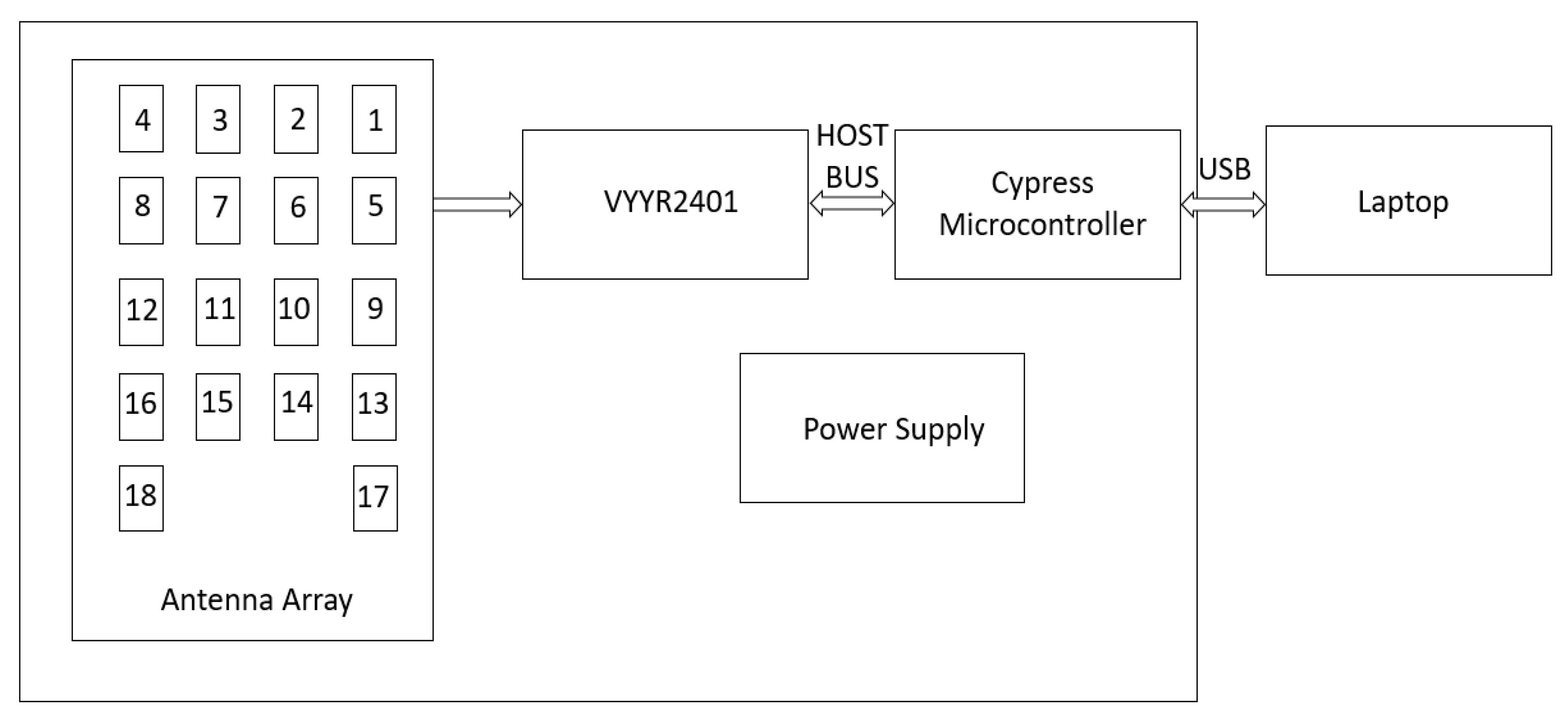
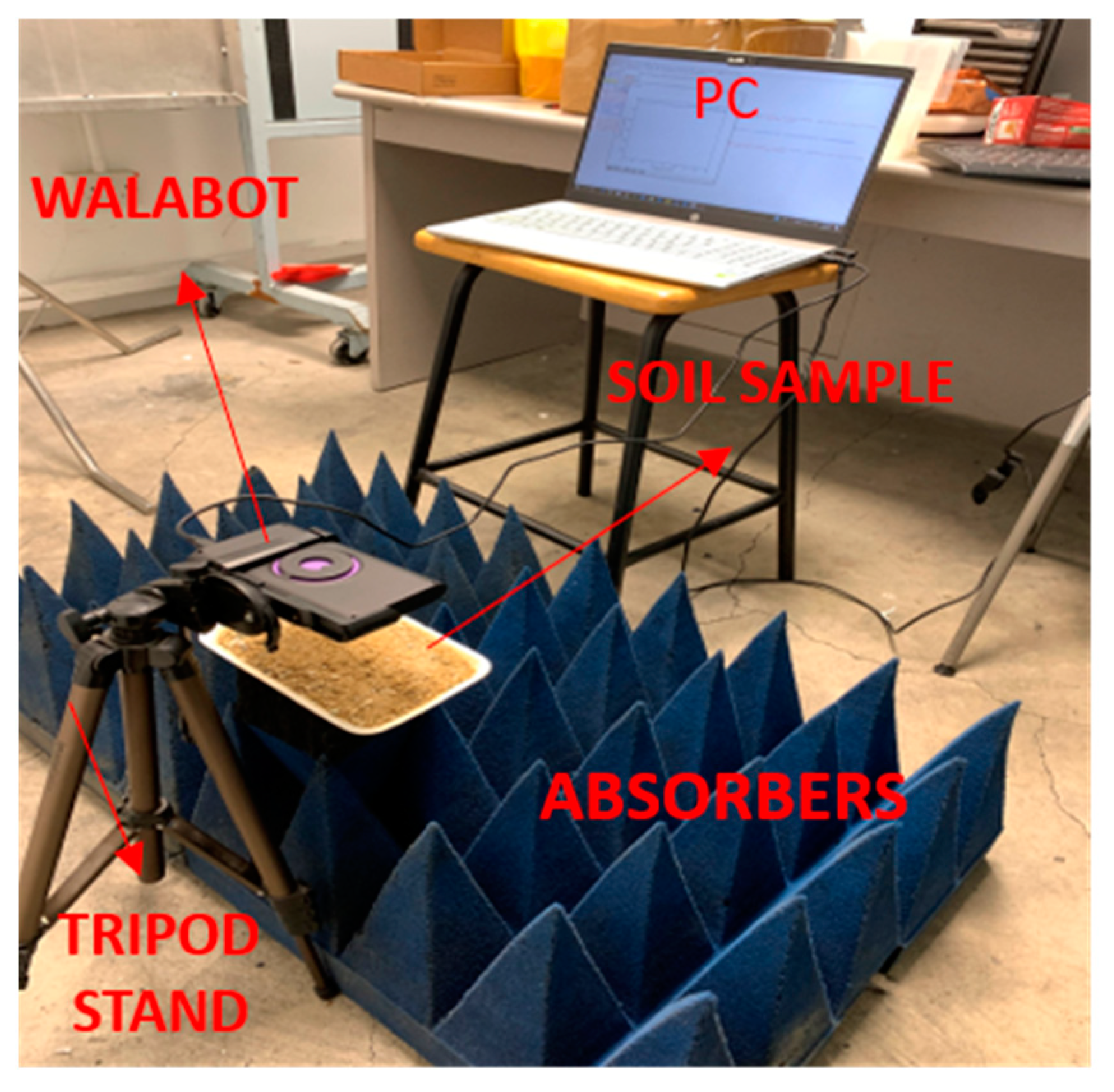
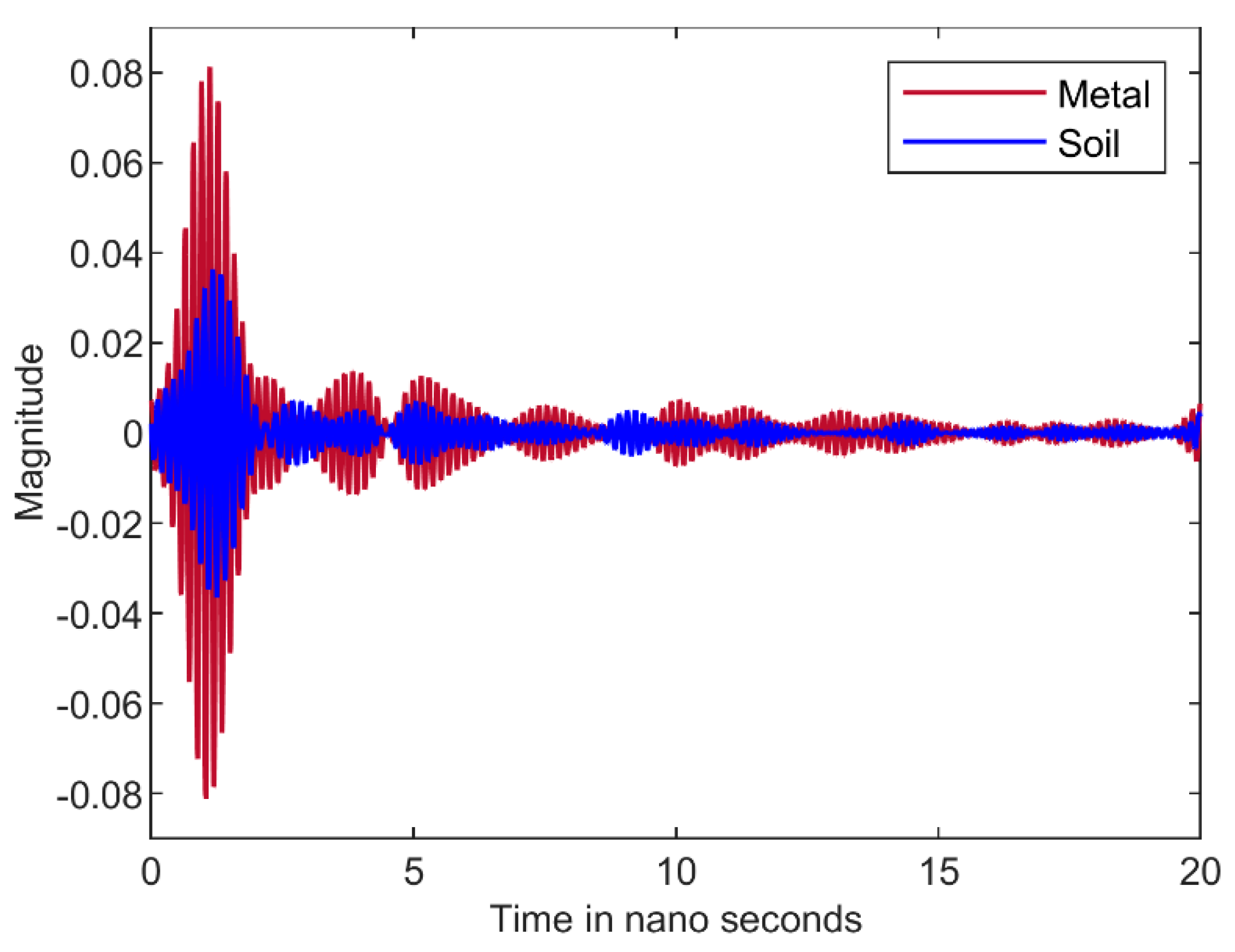
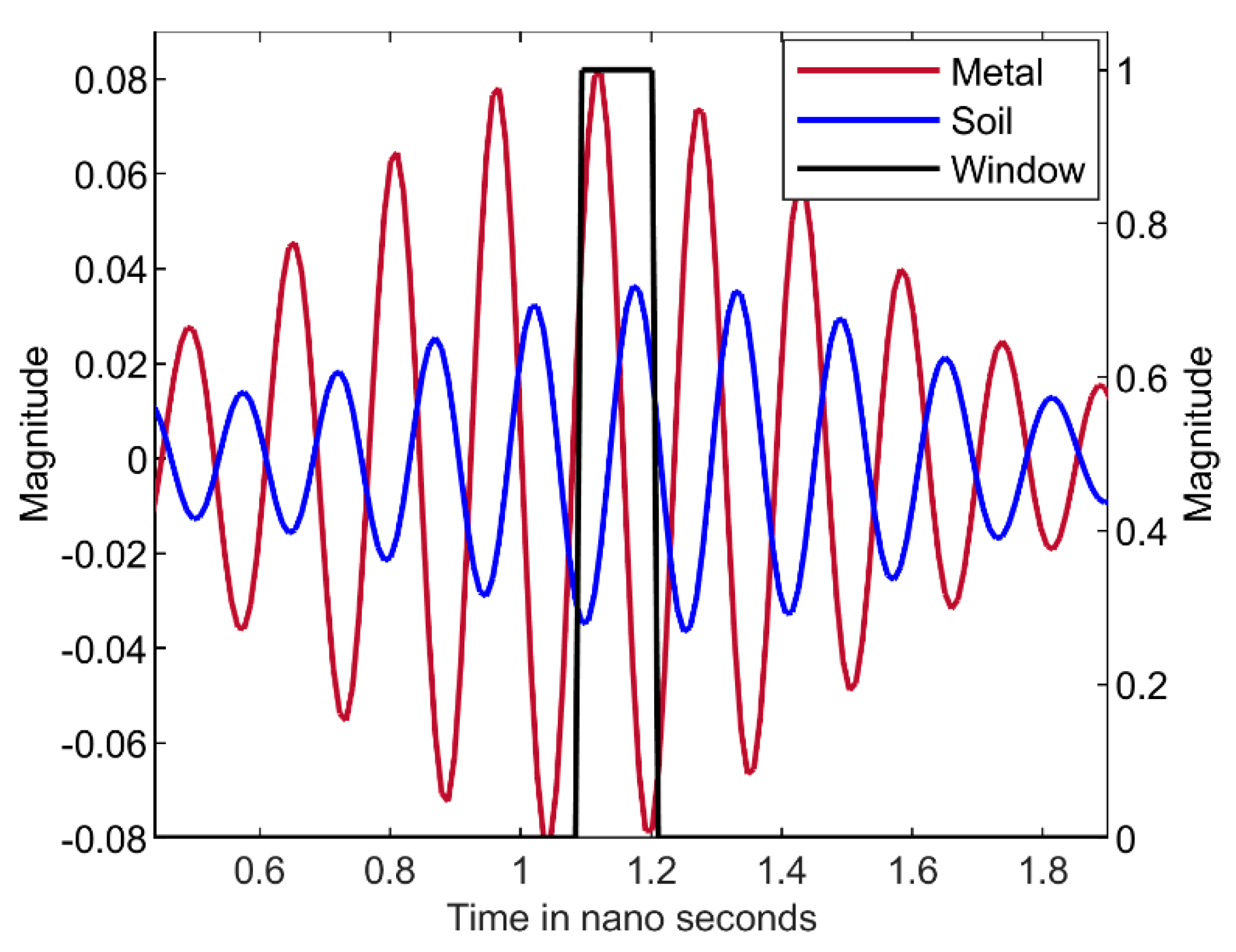
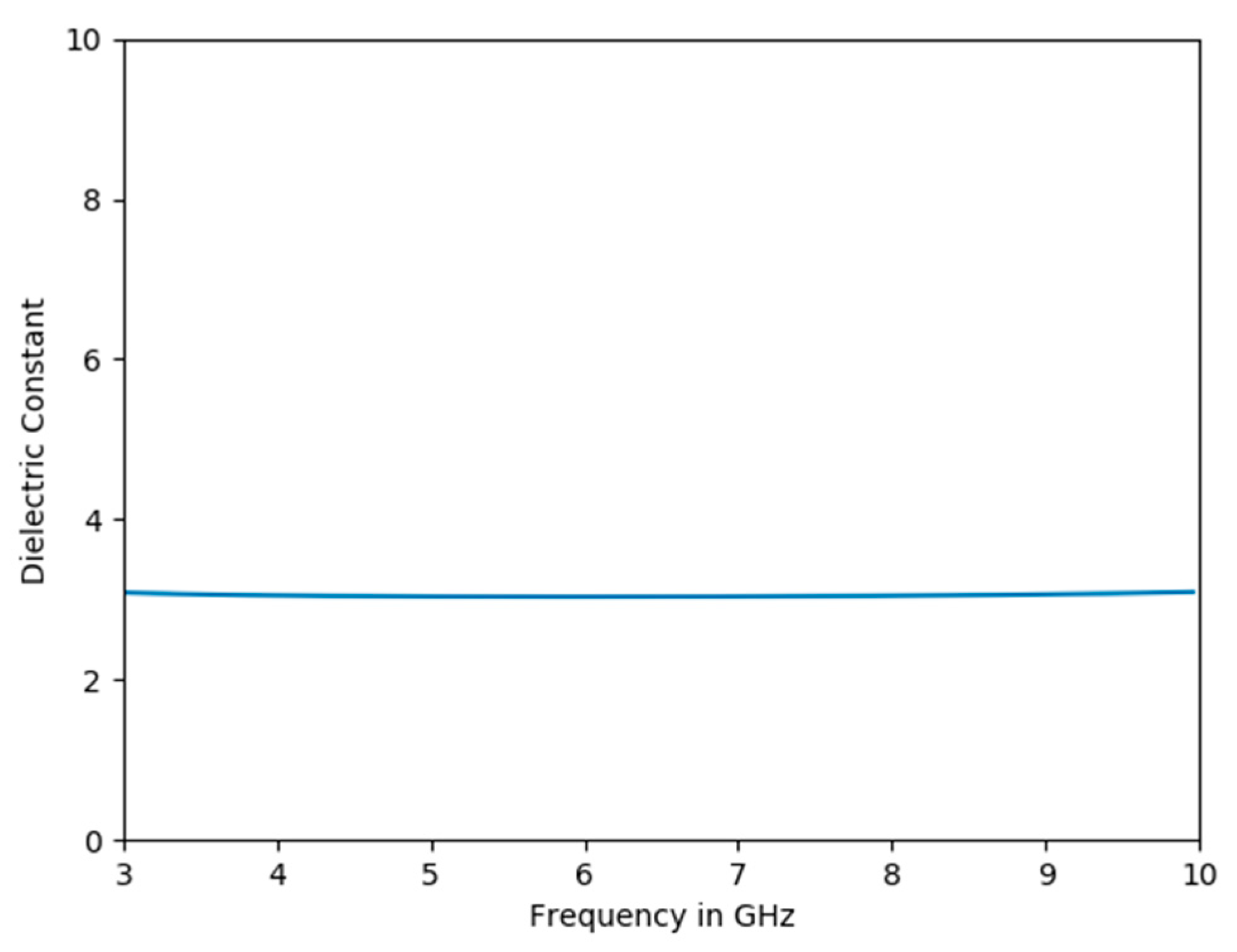

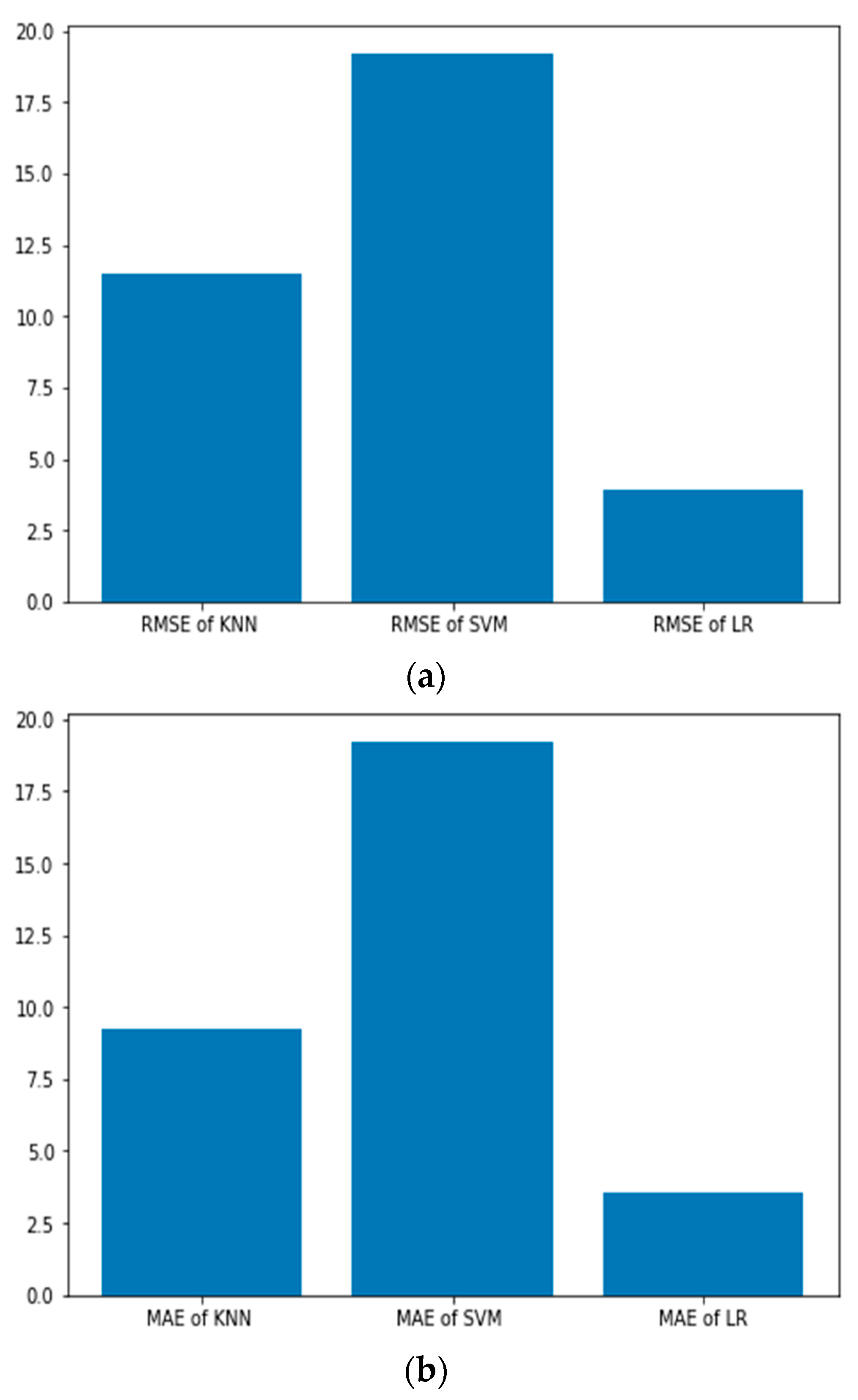
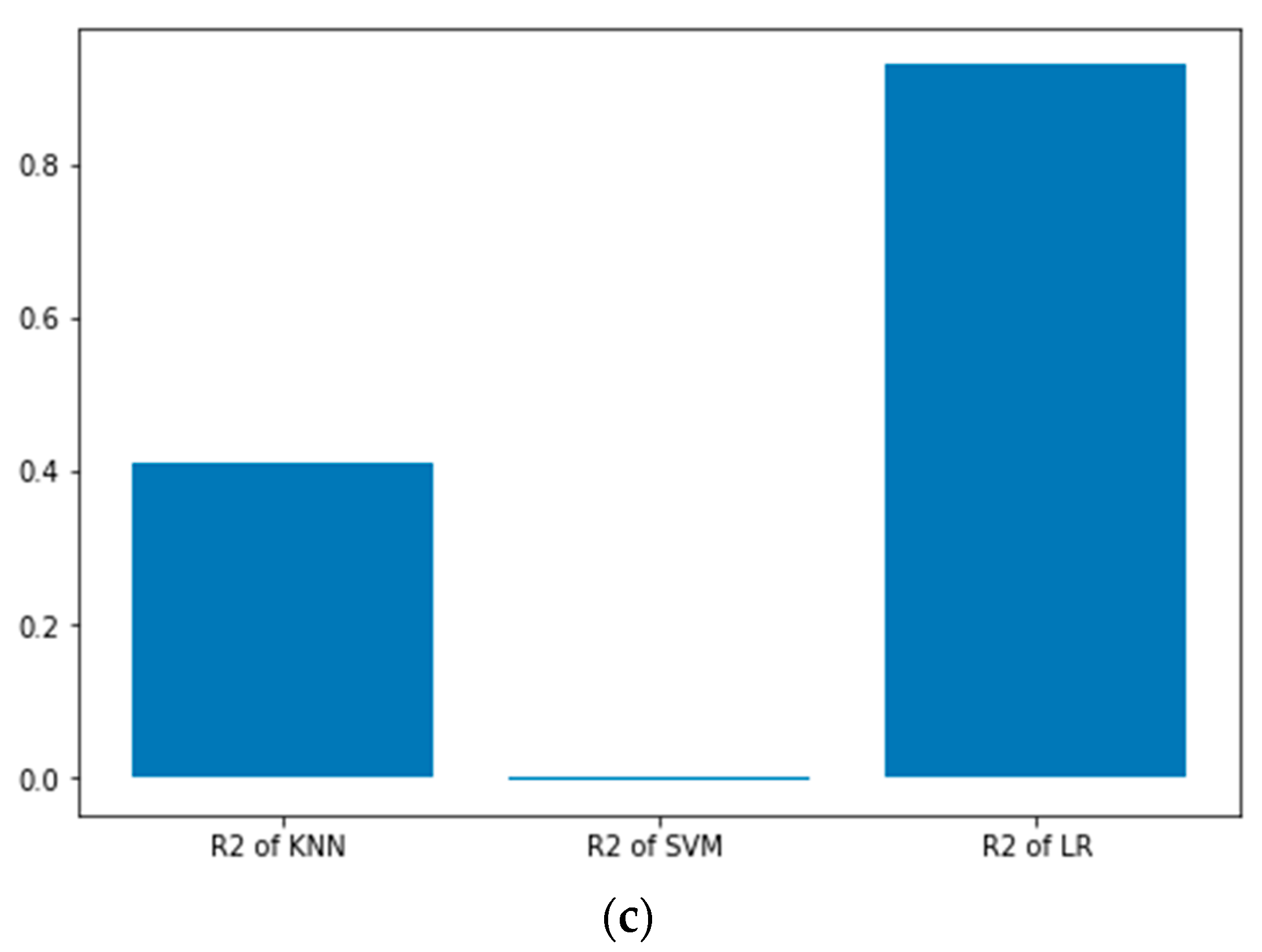
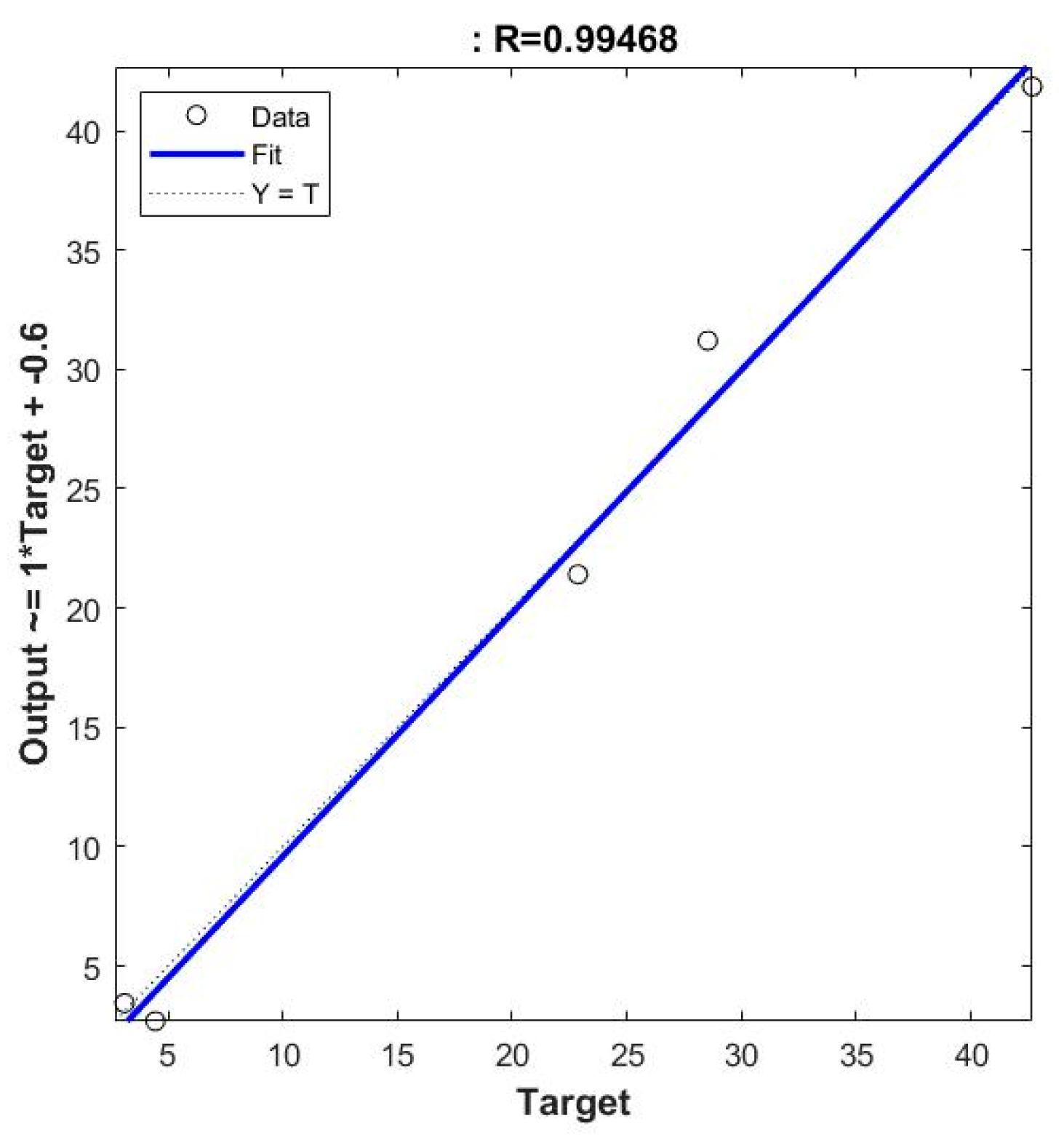
| Soil Moisture Measured Using Vernier Sensor (VWC) | Soil Moisture Determined from the Microwave Experiment (VWC) |
|---|---|
| −1.5% | 3.14% |
| −1.5% | 3.03% |
| −1.5% | 3.10% |
| −1.5% | 3.13% |
| 2.2% | 4.44% |
| 2.2% | 5.31% |
| 2.2% | 5.45% |
| 19% | 26.38% |
| 19% | 22.87% |
| 19% | 22.89% |
| 25% | 28.53% |
| 25% | 31.47% |
| 25% | 32.87% |
| 37% | 40.69% |
| 37% | 42.40% |
| 37% | 42.68% |
| Soil Moisture Measured Using Vernier Sensor (VWC) | Soil Moisture Determined from the Microwave Experiment (VWC) |
|---|---|
| 2.6% | −0.422% |
| 2.6% | −1.226% |
| 2.6% | 1.783% |
| 26.5% | 14.547% |
| 28.0% | 15.187% |
| 31.9% | 16.45% |
| 38.5% | 27.394% |
Publisher’s Note: MDPI stays neutral with regard to jurisdictional claims in published maps and institutional affiliations. |
© 2022 by the authors. Licensee MDPI, Basel, Switzerland. This article is an open access article distributed under the terms and conditions of the Creative Commons Attribution (CC BY) license (https://creativecommons.org/licenses/by/4.0/).
Share and Cite
Uthayakumar, A.; Mohan, M.P.; Khoo, E.H.; Jimeno, J.; Siyal, M.Y.; Karim, M.F. Machine Learning Models for Enhanced Estimation of Soil Moisture Using Wideband Radar Sensor. Sensors 2022, 22, 5810. https://doi.org/10.3390/s22155810
Uthayakumar A, Mohan MP, Khoo EH, Jimeno J, Siyal MY, Karim MF. Machine Learning Models for Enhanced Estimation of Soil Moisture Using Wideband Radar Sensor. Sensors. 2022; 22(15):5810. https://doi.org/10.3390/s22155810
Chicago/Turabian StyleUthayakumar, Akileshwaran, Manoj Prabhakar Mohan, Eng Huat Khoo, Joe Jimeno, Mohammed Yakoob Siyal, and Muhammad Faeyz Karim. 2022. "Machine Learning Models for Enhanced Estimation of Soil Moisture Using Wideband Radar Sensor" Sensors 22, no. 15: 5810. https://doi.org/10.3390/s22155810
APA StyleUthayakumar, A., Mohan, M. P., Khoo, E. H., Jimeno, J., Siyal, M. Y., & Karim, M. F. (2022). Machine Learning Models for Enhanced Estimation of Soil Moisture Using Wideband Radar Sensor. Sensors, 22(15), 5810. https://doi.org/10.3390/s22155810





